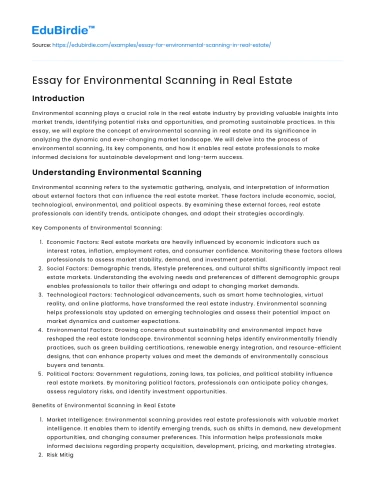Introduction
Environmental scanning plays a crucial role in the real estate industry by providing valuable insights into market trends, identifying potential risks and opportunities, and promoting sustainable practices. In this essay, we will explore the concept of environmental scanning in real estate and its significance in analyzing the dynamic and ever-changing market landscape. We will delve into the process of environmental scanning, its key components, and how it enables real estate professionals to make informed decisions for sustainable development and long-term success.
Understanding Environmental Scanning
Environmental scanning refers to the systematic gathering, analysis, and interpretation of information about external factors that can influence the real estate market. These factors include economic, social, technological, environmental, and political aspects. By examining these external forces, real estate professionals can identify trends, anticipate changes, and adapt their strategies accordingly.
Save your time!
We can take care of your essay
- Proper editing and formatting
- Free revision, title page, and bibliography
- Flexible prices and money-back guarantee
Key Components of Environmental Scanning:
- Economic Factors: Real estate markets are heavily influenced by economic indicators such as interest rates, inflation, employment rates, and consumer confidence. Monitoring these factors allows professionals to assess market stability, demand, and investment potential.
- Social Factors: Demographic trends, lifestyle preferences, and cultural shifts significantly impact real estate markets. Understanding the evolving needs and preferences of different demographic groups enables professionals to tailor their offerings and adapt to changing market demands.
- Technological Factors: Technological advancements, such as smart home technologies, virtual reality, and online platforms, have transformed the real estate industry. Environmental scanning helps professionals stay updated on emerging technologies and assess their potential impact on market dynamics and customer expectations.
- Environmental Factors: Growing concerns about sustainability and environmental impact have reshaped the real estate landscape. Environmental scanning helps identify environmentally friendly practices, such as green building certifications, renewable energy integration, and resource-efficient designs, that can enhance property values and meet the demands of environmentally conscious buyers and tenants.
- Political Factors: Government regulations, zoning laws, tax policies, and political stability influence real estate markets. By monitoring political factors, professionals can anticipate policy changes, assess regulatory risks, and identify investment opportunities.
Benefits of Environmental Scanning in Real Estate
- Market Intelligence: Environmental scanning provides real estate professionals with valuable market intelligence. It enables them to identify emerging trends, such as shifts in demand, new development opportunities, and changing consumer preferences. This information helps professionals make informed decisions regarding property acquisition, development, pricing, and marketing strategies.
- Risk Mitigation: By analyzing external factors, real estate professionals can anticipate potential risks and challenges. This proactive approach allows them to develop contingency plans, adapt their strategies, and minimize potential negative impacts on investments.
- Sustainable Development: Environmental scanning promotes sustainable practices in the real estate industry. By identifying and incorporating environmentally friendly design and construction practices, professionals can create properties that are energy-efficient, reduce carbon footprints, and enhance long-term value. This aligns with the growing demand for sustainable and eco-friendly properties.
- Competitive Advantage: Environmental scanning provides a competitive edge in the real estate market. By staying informed about market trends and consumer preferences, professionals can differentiate their offerings, tailor their marketing strategies, and provide unique value propositions that meet the evolving needs of buyers and tenants.
Implementing Environmental Scanning in Real Estate: a. Data Collection: Real estate professionals should gather data from a variety of sources, including industry reports, market research, government publications, and surveys. They can also utilize technological tools and analytics platforms to monitor and analyze market data effectively.
- Analysis and Interpretation: Once data is collected, professionals should analyze and interpret the information to identify patterns, trends, and potential implications for the real estate market. This involves assessing the data in the context of economic, social, technological, environmental, and political factors.
- Strategic Decision-making: The insights gained through environmental scanning inform strategic decision-making in real estate. Professionals can use the information to determine investment strategies, assess property development opportunities, evaluate pricing strategies, and align their offerings with market demand.
Conclusion:
Environmental scanning is an essential tool in the real estate industry for understanding market dynamics, identifying opportunities, and mitigating risks. By analyzing economic, social, technological, environmental, and political factors, real estate professionals can make informed decisions that drive sustainable development and long-term success. The adoption of environmental scanning practices enables professionals to adapt to changing market trends, meet customer expectations, and contribute to a more sustainable and resilient real estate sector.






 Stuck on your essay?
Stuck on your essay?

